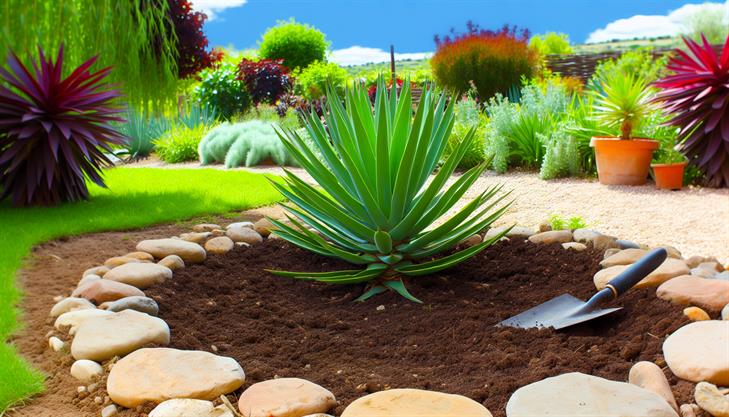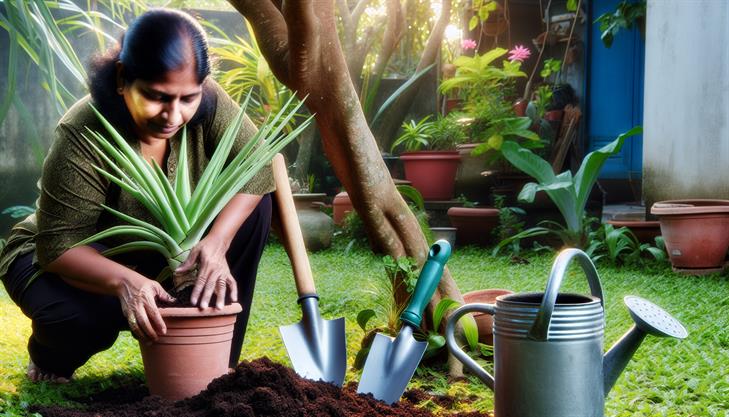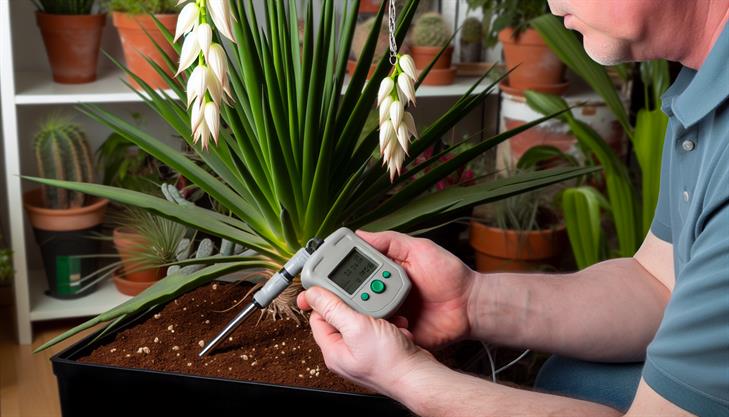Have you ever found yourself standing in the gardening aisle, staring at a yucca plant and wondering if you’re about to engage in a successful horticultural endeavor or… let’s face it, another plant perishing on your watch? You’re not alone. Yucca plants, with their striking sword-like leaves and low-maintenance reputation, have become a favorite among plant enthusiasts for both indoor and outdoor settings. However, the key to unlocking their true potential lies in mastering the art of soil moisture. Do these desert dwellers thrive in bone-dry conditions, or do they prefer something a bit more, well, damp? Understanding the moisture needs of your yucca could be the difference between a thriving plant and yet another disappointing gardening tale. Dive into this guide to unravel the mystery of yucca soil preferences and transform your plant into the resilient beauty it’s destined to be. Whether you’re a seasoned gardener or a curious newcomer, this comprehensive exploration will provide the insights you need to keep your yucca flourishing.
Understanding Yucca Plant Soil Needs
Yucca plants are known for their striking appearance and hardy nature, making them a popular choice for both indoor and outdoor gardens. Understanding the soil needs of yucca plants is crucial for their growth and vitality. One common question that arises among gardeners is, "Do yucca plants need dry or wet soil?" Let’s explore this question in depth to help you cultivate healthy yucca plants.
Soil Moisture Preferences for Yucca Plants
Yucca plants naturally thrive in arid regions, which sheds light on their preference for dry soil conditions. Ideally, yucca plants require well-draining soil that allows excess water to move away from the roots, preventing waterlogging which can lead to root rot. Therefore, the mantra for successfully growing yucca is "dry, not wet."
Choosing the Right Soil Type
-
Well-Draining Soil: The key to happy yucca plants is well-draining soil. A cactus or succulent mix is often recommended because it typically contains a combination of sand, perlite, and other materials that enhance drainage.
-
Soil Amendment: If you are working with native soil that retains water, consider amending it by mixing in gritty materials such as coarse sand or gravel. This modification will improve aeration and drainage.
Watering Instructions
Adhering to a suitable watering schedule is essential to mimic the natural conditions where yuccas grow:
-
Infrequent Watering: Yucca plants prefer to dry out between waterings. Wait until the top 1 to 2 inches of soil are completely dry before adding water. This typically means watering every two to three weeks, depending on the climate and season.
-
Winter Dormancy: Reduce the watering frequency during the winter months when the plant’s growth slows down. Winter is a period of dormancy, and excess water during this time can be detrimental.
Setting Up a Proper Environment
-
Location: While soil is critical, the placement of your yucca plant also influences soil moisture levels. Ensure your yucca receives plenty of sunlight, as it helps in drying out the soil.
-
Container Selection: If growing yucca in a pot, choose one with ample drainage holes. Layer the bottom with small stones or pebbles before adding soil to further aid drainage.
Common Issues and Solutions
-
Root Rot: Often caused by overly wet conditions, root rot manifests as yellowing leaves and mushy roots. To resolve this, ensure your soil is well-draining and reduce watering frequency.
-
Leaf Browning: While yuccas prefer dry conditions, excessively dry periods can cause browning tips. If this occurs, slightly increase watering frequency but avoid saturating the soil.
Additional Tips for Yucca Care
-
Monitor Humidity: Yucca does not fare well in high humidity environments. Ensure your plant is in a well-ventilated area to mimic the breezy, dry air of its native habitat.
-
Fertilize Sparingly: Use a balanced, slow-release fertilizer in the spring to encourage growth, but avoid over-fertilization, which can lead to salt buildup in the soil.
Understanding and accommodating the dry soil needs of yucca plants will promote their health and prevent common issues associated with improper soil moisture. By following these guidelines, your yucca plants can flourish, adding a beautiful, maintenance-friendly touch to your home or garden.
Tips for Maintaining Optimal Soil Moisture
Yucca plants, originally native to arid regions of the Americas, have adapted over time to thrive in specific soil moisture conditions. If you’re wondering whether yucca plants need dry or wet soil, the answer tilts towards the former. Here’s a detailed guide on maintaining optimal soil moisture for yucca plants, ensuring healthy growth and avoiding common pitfalls.
Understanding Yucca Plant Soil Preferences
Yucca plants prefer dry to moderately moist soil conditions, mimicking their natural desert habitat. The key to ensuring their health is to balance enough moisture for growth without causing waterlogging, which can lead to root rot.
Maintaining the Right Soil Moisture for Yucca Plants:
-
Select Well-Draining Soil:
- Use a sandy or loamy potting mix that supports adequate drainage. A cactus or succulent soil mix is often ideal for yucca plants. This type of soil prevents water from sitting around the roots, which could promote rotting.
-
Pot with Drainage Holes:
- If planting yucca in a container, ensure that it has ample drainage holes. This setup helps water escape quickly and prevents over-saturation of the soil.
-
Watering Technique:
- Observe the Topsoil: Before you water, check the top inch of soil. It should be completely dry before you introduce more water.
- Deep Watering Method: Water until you see it coming out from the drainage holes, indicating the entire root ball is hydrated. This reduces the frequency of watering since the plant has enough moisture stored.
-
Seasonal Water Adjustments:
- During growing seasons like spring and summer, yuccas may need slightly more moisture. However, in winter, reduce watering significantly as growth slows and evaporation is less intense.
-
Indoor vs. Outdoor Conditions:
- Indoor Tips: Yucca plants grown indoors may require less frequent watering than those outdoors due to reduced exposure to elements and lower evaporation rates.
- Humidity Considerations: While outdoor humidity levels can naturally adjust soil moisture, indoor conditions might require additional monitoring with a hygrometer to maintain the right environment.
Common Issues and How to Avoid Them:
-
Overwatering: The most common issue associated with yucca plant care is overwatering. Symptoms include yellowing leaves, mushy roots, and stem rot. If these appear, reduce watering and check drainage efficiency.
-
Underwatering: While less common, underwatering can cause the leaves to brown or wilt. Adjust your watering schedule to ensure the soil doesn’t become overly dry.
Additional Advice:
-
Mulching: Although not essential, a thin layer of gravel or pebbles on the soil surface can help reduce evaporation, especially if yucca plants are grown in warmer environments.
-
Checking Soil Compaction: Over time, soil can become compacted, reducing drainage efficiency. If you notice this, gently aerate the soil or consider repotting to refresh the environment.
By understanding and maintaining the proper soil moisture, you can ensure that your yucca plants remain healthy and vibrant. Regularly observing your plant’s condition and adjusting care routines as needed will contribute to their long-term well-being.
Selecting the Right Soil Type for Yuccas
When it comes to selecting the right soil for yucca plants, understanding their natural habitat is crucial. Do yucca plants need dry or wet soil? The short answer is that yucca plants thrive in dry soil conditions, which mimic the arid environments where they naturally grow.
Understanding Yucca Plant Soil Needs
Yuccas are native to the desert regions of the Americas and have adapted to survive in sandy, well-drained soils with low fertility. These plants are highly resistant to drought and can become susceptible to root rot if exposed to overly wet conditions. Therefore, providing soil that facilitates quick drainage is essential for their health.
Creating the Ideal Soil Mix
-
Choose the Right Soil Components:
- Use a commercial cactus or succulent soil mix, as these are specifically designed for plants that require excellent drainage.
- Alternatively, you can create your own mix by combining equal parts of regular potting soil, coarse sand, and perlite or gravel. This combination ensures the soil remains loose and airy, promoting better drainage.
-
Pot Selection and Drainage:
- Select containers with drainage holes at the bottom for potted yucca plants. This prevents water from accumulating at the base, which can lead to root rot.
- Utilize pots made of breathable materials like terracotta, which can further help manage soil moisture levels.
-
Layering for Enhanced Drainage:
- Place a layer of gravel or small stones at the bottom of the pot before adding soil. This additional step improves drainage and prevents soil from clogging the drainage holes.
Watering and Maintenance Tips
-
Water Sparingly: Once established, water yucca plants infrequently. Allow the soil to dry out completely between waterings. During the growing season, watering once a week is generally sufficient, but reduce this frequency in the winter months.
-
Check Soil Moisture: Before watering, check the soil moisture using your finger. If the top inch of soil feels dry, it is a good indication that the plant needs water. Avoid watering if the soil still feels damp.
-
Avoid Overwatering: Overwatering is a common issue leading to root rot, yellowing leaves, and plant decline. Always err on the side of underwatering rather than overwatering.
Additional Advice for Healthy Yucca Plants
-
Outdoor Planting Considerations: When planting yuccas outdoors, choose a sunny location with well-drained soil, similar to its potting mix. Avoid low-lying areas where water collects.
-
Handling Climate Variability: In areas with heavy rainfall or high humidity, consider planting yuccas in raised beds or mounds to aid drainage.
By providing yucca plants with dry, well-draining soil, you mimic their natural growing conditions, ensuring vibrant health and robust growth. These measures not only foster an ideal environment but also help avoid common pitfalls associated with improper soil moisture levels.
How to Measure Soil Moisture for Yucca Plants
Yucca plants are popular for their striking appearance and low maintenance needs, making them a favorite among gardeners both indoors and outdoors. One of the most frequently asked questions is: do yucca plants need dry or wet soil? Understanding the optimal moisture level for yucca plants is crucial for ensuring their healthy growth.
Understanding Yucca Plant Soil Moisture Needs
Yucca plants thrive in conditions that mimic their natural habitat, which is typically arid or semi-arid landscapes. This means they prefer soil that leans more towards the dry side rather than consistently wet. Overwatering is a common issue with yuccas because they are susceptible to root rot if soil remains soggy for prolonged periods.
The Ideal Soil Conditions for Yucca Plants
-
Well-Draining Soil: Yucca plants need well-draining soil to flourish. A soil mix that combines sand, perlite, and potting soil works well, as it ensures excess moisture drains away quickly.
-
Dry Rather than Wet: Between watering, allow the soil to dry out completely. Testing the top inch or two of soil with your finger is a simple and effective way to check for dryness. If the soil feels dry to the touch at this depth, it’s time to water your plant.
Step-by-Step Guide to Measuring Soil Moisture
-
Finger Test: Insert your finger into the soil about two inches deep. If it feels dry, it’s an indicator your plant needs watering. If it’s moist, hold off on watering for a few more days.
-
Moisture Meter: For a more precise measurement, consider using a soil moisture meter. Insert the probe into the soil according to the manufacturer’s instructions. A reading in the low range typically means the soil is dry and a watering session is needed.
-
Visual Inspection: Inspect the leaves and the soil surface. Yucca leaves that start to feel soft or display discoloration may indicate overwatering. The same goes for soggy or consistently dark soil, which suggests the need to extend the period between waterings.
Common Issues with Yucca Soil Moisture
-
Overwatering: This is the biggest threat to yucca plants. Symptoms include yellowing leaves and a mushy stem base. To remedy, improve drainage by repotting with the correct soil mix and ensure your pot has drainage holes.
-
Underwatering: A less common problem, underwatering leads to browning and crispy leaf tips. Regularly check soil moisture and ensure you water deeply, allowing water to reach all the roots.
Additional Tips for Yucca Plant Care
- Pot and Placement: Use a pot with ample drainage holes and place your yucca in a spot with plenty of natural light.
- Consistent Watering Schedule: Create a watering routine based on your local climate and indoor conditions. In warmer months, yuccas may need watering every two weeks, while in cooler periods, once a month may suffice.
By paying close attention to these signs and using the right soil moisture measuring techniques, you’ll be able to provide your yucca plants with the optimal environment they need to thrive. Keeping their soil primarily dry will help prevent common problems associated with improper watering, ensuring a healthy, vibrant plant.
Troubleshooting Common Yucca Soil Issues
Yucca plants, known for their striking appearance and resilience, thrive in conditions similar to their native arid environments. Understanding whether yucca plants prefer dry or wet soil is crucial for their health and growth. In essence, yucca plants need dry soil conditions to flourish.
Understanding Yucca Soil Preferences
Yucca plants naturally grow in desert regions where the soil drains quickly and retains little moisture. Therefore, these plants are genetically predisposed to prefer dry soil over wet soil. When planted in excessively moist conditions, yuccas are prone to several problems, such as root rot and fungal infections. Here’s a closer look at how to achieve the ideal soil conditions for your yucca.
Steps to Ensure Dry Soil for Yucca Plants
-
Select Appropriate Soil:
- Opt for a well-draining potting mix, such as a cactus or succulent-specific blend. This type of soil typically contains sand, perlite, and small aggregates that enhance drainage.
- Alternatively, create your own mix by combining regular potting soil with coarse sand or gravel in a 2:1 ratio.
-
Check Pot and Drainage:
- Ensure that your planting pot has adequate drainage holes at the bottom. This feature is crucial to prevent water from pooling around the roots.
- Consider adding a layer of small stones or gravel at the base of the pot to further aid in drainage.
-
Watering Techniques:
- Water yucca plants sparingly. A good rule of thumb is to water your yucca only when the top inch of soil feels completely dry. Over time, you will develop a watering schedule that suits your local climate and indoor conditions.
- When watering, do so until water drains through the bottom of the pot, then allow the soil to dry out completely before the next watering.
-
Avoid Humidity:
- Place your yucca plant in an area with low humidity and good airflow. High humidity levels can mimic wet conditions and complicate the drying process.
Common Issues and Additional Tips
Root Rot:
One of the most common issues faced by yucca plants is root rot, typically caused by overwatering or poor drainage. Signs of root rot include yellowing leaves and a generally wilting appearance. If you suspect root rot, carefully remove the plant from its pot, check its roots, and cut away any mushy, discolored sections.
Signs of Overwatering:
If the leaves of your yucca plant are turning yellow or brown and feel soft, it may indicate overwatering. Adjust your watering routine to accommodate drier soil conditions.
Ideal Environmental Conditions:
- Yucca plants prefer bright, indirect sunlight. However, they can tolerate some direct sun exposure, which can help the soil dry out between waterings.
- Maintain moderate temperatures around the plant. Avoid exposing your yucca to extreme cold or heat, which can affect soil moisture levels.
By following these guidelines and understanding the yucca plant’s natural preference for drier conditions, you can ensure a healthy, thriving plant. From choosing the right soil to implementing a careful watering routine, these steps will help you create an environment where your yucca can grow successfully.
In conclusion, understanding the soil needs of yucca plants is crucial for their thriving growth and overall health. Key takeaways include recognizing that yuccas naturally thrive in dry, well-draining soil, similar to their native desert habitats. Overwatering or planting them in soil that retains too much moisture can lead to root rot and other complications. Thus, allowing the soil to dry out between waterings and ensuring proper drainage is paramount to keeping your yucca vibrant and healthy.
Applying these insights into your gardening practices can help you cultivate a resilient and stunning yucca plant that enhances your living space, whether inside or in your garden. Remember, balance is key: too dry can stress the plant, while too wet can cause damage.
As a final tip, consider repotting your yucca with a cactus or succulent soil mix if you’re growing it indoors, as this will aid in maintaining suitable moisture levels and replicating its natural environment. Happy gardening!


